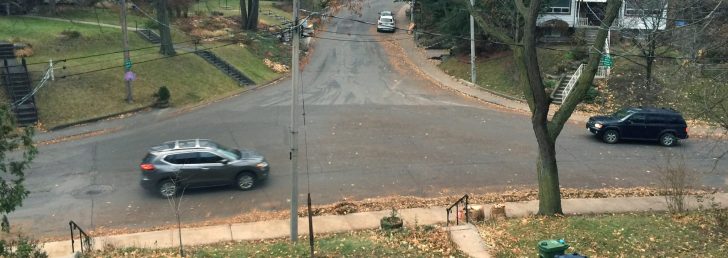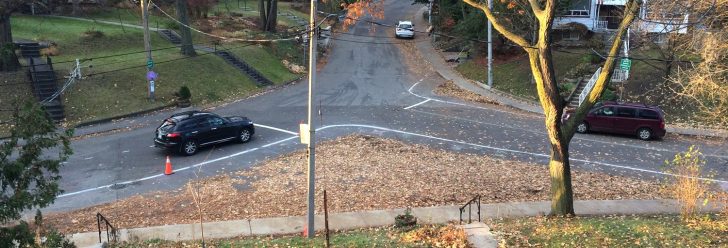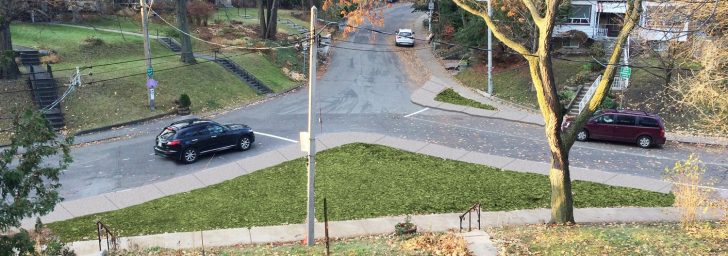In winter months, urban activists and designers have been known to observe where people drive and walk through snow, then use that information to redraw streets and sidewalks. But this year, one Toronto resident didn’t wait for “snowy neckdowns” (or: sneckdowns) to see if he and his neighbors could test safety measures at a local intersection.

So David Meslin gathered a group to create a set of temporary curb extensions. The main ingredients: a one-to-one ratio of cornstarch and water for the solid white lines plus leaves from area yards. The guidelines helped direct cars while leaf piles visually reinforced them, encouraging vehicles to follow a modified path. This soft “leafy neckdown” redesign didn’t prevent anyone from driving over the lines or through the leaves, but reshaped traffic behavior nonetheless.

“Last week I got together with some neighbors,” Meslin explained in a social media post, “and we temporarily re-designed a dangerous intersection near our homes. Using only chalk and leaves (and maintaining all existing road widths at 28 feet) we revealed a surplus surface area of 2,000 square feet which could be transformed into a parkette, new sidewalks, and much shorter/safer crossings.”

The idea behind these kinds of changes is relatively simple: if cars don’t need the space, why give it to them? Narrower roads (that are still sufficiently wide for vehicles) tend to slow cars down and reduce crossing times, making things less dangerous for pedestrians. And, of course, that freed-up space can be put to better use, too.
Guerrilla interventions like this may be impermanent, but they can help highlight areas for potential improvement and illustrate how easily cars can adapt to small changes on city streets. Of course, not all municipalities will take kindly to this type of citizen action — stay safe!



Comments (13)
Share
This is fantastic
A simple roundabout would be a better solution.
Roundabouts aren’t the solution to every intersection. They take up more space than a traditional back road T intersection because they have a minimum functional diameter.
Easily convert asphalt to “traffic calming” brick-like design. http://www.ennisflintamericas.com/get-inspired/trafficpatternsxd-fairfield-ca
Shove “traffic-calming.” The last thing we need is MORE congestion.
This is HORRIBLE. You’re encouraging people to start redesign traffic patterns as they see fit. Do you realize the very likely outcome of non-professionals doing this kind of work? What happens when one neighbor changes the traffic pattern, and another neighbor doesn’t like it and changes it back? What happens when some moron forgets a stop sign and a kid gets killed by a car? Is the driver at fault for obeying what they thought were legal road markings? Or the guy who changed the road markings? Is, “I was just trying to make it better,” a valid defense when someone is injured? What happens when people get used to these stupid new lines and they are washed away by rain…it’s quite conceivable that someone familiar with the false lines that are no longer there will act in the newly learned way while encountering a driver who only sees the legal, valid lines and there is an accident because they’re following two sets of traffic markings.
I get it, we love citizens taking an active life in their own community and having a say in how things are designed, but this is absurd. Calling yourself and ‘urban activist’ doesn’t mean anything and it isn’t a license to do whatever you want cause you feel empowered. Unless you’re a professional you don’t know what you’re doing and your common sense approach to making new traffic patterns will undoubtedly cause more harm than good. If you don’t like the traffic patterns, get involved in your local government instead of taking matters into your own hands. Things like this can be changed in a safe, orderly, and legal way.
This is an incredibly awful idea and your promotion of it is reckless. I’m appalled author and editors of this site, this is beyond dangerous to encourage. I don’t think it would be too difficult to make a case that you have some legal culpability in an injury if someone reads this nonsense and acts upon it. I hope what you’ve written here doesn’t get anyone killed.
It looks to me like you just eliminated all street parking for that park in the picture while simultaneously forcing bicycles closer to cars.
That’s beyond the hubris and irresponsibility of nominating yourself to implement design changes.
Well, according to Toronto laws you have to ride as far to the right as possible. However, as an experienced rider, this is just asking for trouble as cars pass you much closer than is comfortable (higher the speed the more space buffer you should offer to cyclist). So in this case I would take up the center lane (technically in violation of local law) and move to the right to allow cars to pass safely. If they can’t pass safely, you bet your ass (I bet my ass would be more appropriate) that I would take up the center of the lane to block cars trying to pass dangerously close to me.
What would your do about a bridge that is just a bit too low for modern standards?
https://youtu.be/USu8vT_tfdw
As an aside, if that’s what they consider a dangerous intersection then Toronto must be the safest place in the universe.
See the comments section of Jalopnik for a detailed and thorough analysis both for and against: https://jalopnik.com/some-brilliant-toronto-residents-fixed-this-intersectio-1820931621
I get why some folks would be up in arms about rebel citizens not taking into consideration proper street engineering, other considerations, etc. I get it, I do. I’ve been to city planning meetings about whether to put an additional handicap street parking spot, permit parking and city zones, no parking signs and where to put them, etc. I was surprised at the level of thoughtfulness and discussion at these meetings, trying to balance the needs of everyone who live in the neighborhood as well as visitors to homes and businesses.
At the same time, this wasn’t a permanent setup, and it was a temporary experiment to see how traffic would behave with their changes. Traffic engineers aren’t perfect, and while I know that they often sit and observe traffic before making changes (at least in busy areas) I doubt they will have time to sit and observe a quiet neighborhood intersection like this one. If anything, it provides some solid evidence that changes need to be made to this intersection to improve the safety and flow of traffic.
These neighbors live there, and they have literal street level knowledge of how traffic operates (poorly as it turns out) in this intersection, and they decided to do something about it. As it turns out, the stop signs are set far back from the intersection, and so you have a large free-for-all zone in the middle of that expanse of asphalt. That’s also assuming drivers see the stop signs, which apparently they don’t because they often don’t stop (according to neighbors).
In addition, you also have to consider new technology like Waze and Google Maps taking advantage of crowdsourced knowledge and flooding streets with traffic that it wasn’t designed to handle – and which traffic engineers may not know about.
So all in all, I side with the neighbors making the change here. Give them a fine according to the local ordinances AND at the same time make the change that they already tried out.
“Dangerous Intersection” reads the headline, but…nothing about danger in the actual article? Guess they forgot to write about that part. Or else it’s just “cars are inherently dangerous so anything that makes it more inconvenient to drive improves safety”…
Curb extensions act as traffic-calming devices, slowing down cars, which makes roads safer for both drivers and pedestrians.